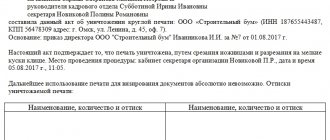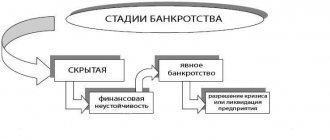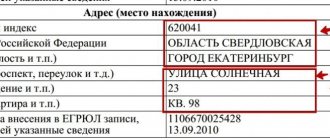When is a monitoring process necessary in the event of a company's insolvency?
Before starting the observation stage, it is necessary to submit a petition to the court to initiate bankruptcy proceedings for a legal entity. The company must meet two parameters:
- The amount of debt to creditors exceeds 300,000 rubles.
- The debt is overdue for more than three months.
Both the management of the enterprise and the creditors themselves can submit an application.
Note! It is not allowed to initiate company insolvency proceedings for personal gain or to steal assets. These acts are punishable by law.
Within a month from the date of filing the petition, it is necessary to initiate the observation stage, but only if the decision has not been challenged by the defendant.
The goals of the court when opening the surveillance process are:
- Calculating the amount of debt, compiling a list of creditors.
- Preservation of assets of the debtor company.
- Determination of the further activities of the company or its liquidation.
Important! It is prohibited to introduce an observation stage if the company has already launched the liquidation process.
Algorithm of actions for bankruptcy of legal entities
The process of declaring a company insolvency must go through certain stages. Let's look at them:
- Submitting a claim to a judicial authority.
- Appointment of an arbitration manager.
- Creation of a complete list of creditors.
- Initiating a meeting of creditors and making a decision to introduce one of the stages of bankruptcy.
- Introduction of the enterprise monitoring stage.
- Approval at a meeting of one of the stages of the procedure: reorganization or external management. The decision is made by voting.
- If none of the stages gives positive results, then the legal entity is declared bankrupt, and the stage of bankruptcy proceedings begins.
- The financial manager conducts a detailed inventory of the defaulter’s property, evaluates it, and creates a bankruptcy estate.
- Organization and holding of an auction at which all the bankrupt’s property must be sold.
- Carrying out settlements with creditors, wrapping up current debt obligations.
- The financial manager reports to creditors and the judicial authority on the results of bankruptcy proceedings. If his report is accepted, the insolvency process is considered completed.
- The financial manager submits to the tax service a resolution declaring the legal entity bankrupt. This decision will serve as the basis for its liquidation.
- The enterprise will be canceled from the Unified Register of Legal Entities and is no longer considered an independent economic entity.
Observation stage. How is it carried out in case of bankruptcy?
As a rule, during the observation stage, the enterprise’s activities continue as before, but with some restrictions:
- The company must not reorganize or open new branches.
- It is not allowed to issue securities and resell shares of the enterprise.
- The list of founders cannot be changed.
- Dividends cannot be paid to shareholders.
- Property transactions are limited to no more than five percent of the book value of the firm's assets.
Interim manager in case of insolvency of an organization
The person selected by the arbitration court becomes responsible for the monitoring process here. The temporary manager must perform the following functions:
- Monitor the work of the company’s management to avoid cases of fictitious bankruptcy proceedings.
- Analysis of the financial position of the enterprise.
- Creating a list of creditors and holding a meeting.
- Creating a report and recommendations during the investigation.
To perform the above functions, the temporary manager must have access to all company documentation. Refusal to provide information will mean that management is obstructing the progress of the audit.
Within thirty days after the introduction of the monitoring stage, creditors have the authority to make claims against the debtor.
Expert opinion
Yurchenko Ekaterina Vasilievna
Deputy Chairman of the Committee for Debt Dispute Resolution and Crisis Management
At a general meeting of creditors, the interim manager talks about the results of the audit and recommends further ways out of the situation. Every decision must be made by voting. The voting results and all important issues are recorded in a special protocol, which must be submitted to the arbitration court within five days.
Important questions:
- What to do next with the debtor company? Introduce the next stage or completely stop the insolvency procedure. The latter means that all restrictions are lifted and all powers are returned to management.
- If the settlement agreement was not signed, and the bankruptcy process itself moved to the next stage, then it is necessary to appoint an arbitration manager by voting. It is also necessary to appoint a creditor committee representing the interests of all creditors, after which the holder of the register is determined.
When the observation stage is completed, the temporary manager must submit to the court a complete package of documents, which will contain the results of the inspection, recommendations and minutes of the meeting of creditors.
The remuneration for the work of the temporary manager must be paid by the debtor.
Temporary manager in the bankruptcy procedure of an enterprise
The monitoring stage in case of bankruptcy of a legal entity must be led by an independent expert appointed by the arbitration court - a temporary manager. In the course of his work, the manager must perform a number of the following tasks:
- monitoring the actions and decisions of management to eliminate fictitious bankruptcy;
- analysis of the organization's financial performance;
- creating a list of creditors and holding the first meeting;
- preparation of conclusions and recommendations based on the results of the audit.
To perform the listed tasks, the temporary manager has the right to gain access to any documentation of the organization, including those containing confidential data. Refusal to provide access by the management of a legal entity is regarded as obstruction of the manager’s work in the monitoring procedure and concealment of reliable data.
To determine the total debt of a legal entity to its creditors, the temporary manager creates a register of debtors, which records the claims of each individual creditor and, depending on the size of the debt, determines its share of vote. The register is formed throughout the entire procedure, however, creditors who submitted their claims in the first 30 days from the date of introduction of supervision are included in the first meeting of creditors and have the right to vote when making decisions on the future fate of the debtor.
The date of the meeting for the purpose of jointly determining the future activities of the legal entity is appointed by the temporary manager no later than 10 days before the end of the procedure. At the meeting, the manager voices the results of his own financial audit and recommends options for getting out of the current situation, which can be accepted or challenged by creditors. The decision on each of the issues put forward is made by voting. The voting results and the list of issues are recorded in the protocol of the observation procedure, which the temporary manager must submit to the arbitration court within five days. The main issues addressed include:
- determining further actions regarding the debtor - introducing the next stage of bankruptcy or completely terminating the procedure, which removes all restrictions on the organization’s activities and restores the powers of the manager;
- if a settlement agreement has not been accepted and the insolvency process has moved to the next stage, an insolvency administrator responsible for its implementation is appointed by a majority vote. In addition, from among those present at the meeting, a creditor committee is determined, which will represent the interests of all creditors, and a register holder is appointed.
Upon completion of the observation stage, a package of documents is generated, which the temporary manager must submit to the arbitration court to make a final decision on terminating the bankruptcy procedure or introducing the next stage. The package of documents includes a report on the activities of the manager, his expert opinion and recommendations, as well as minutes of the meeting of creditors.
This is also important to know:
How bankruptcy is carried out for individuals. persons under mortgage
Please note: As for the remuneration of a temporary manager, its amount is determined in the arbitration court when he is appointed to the position in accordance with Article 20.7 of the bankruptcy law. The remuneration is paid for the entire duration of the procedure, the obligation to pay it falls on the debtor.
How long does the observation stage last in a company insolvency procedure?
The maximum period of this stage from the moment it begins until the moment the documents are transferred to the arbitration court cannot exceed seven months. Of this period, thirty days are spent on the consideration of the bankruptcy petition and the appointment of a temporary receiver by the court. The remaining six months are the expert’s direct work as an observer. As a rule, such work in practice takes from four to five months. If during the monitoring stage a settlement agreement was concluded between the debtor company and the creditors, then, at the request of the creditors, the monitoring process ends early.
Why is the observation stage necessary during bankruptcy proceedings?
When opening a surveillance process, there are always two important goals:
- Preserve the commercial activities of the enterprise, restore its solvency so that it can pay off its debts to creditors.
- Conduct a financial analysis of the enterprise, which will answer the question: is it possible to save the company or is liquidation still necessary?
Beginning of bankruptcy
The adoption of the relevant law “On Insolvency” was a consequence of the fact that many often use bankruptcy and declaring legal insolvency. persons in order to “escape” from fulfilling their own obligations, in order to mislead certain counterparties, to secretly curtail their affairs, with plans to evade the law.
Important: it should be remembered that fictitious bankruptcy is punishable by criminal law.
In order for the bankruptcy process of a legal entity or individual. person has entered into force, you need to file an insolvency petition submitted for consideration to the arbitration court.
Advice! Who can submit such an application? These are creditors, various bodies or direct debtors. The decision to start the trial will be made by the judge.
The main stages of bankruptcy of a legal entity are identified. or physical faces, and we will talk about them in order, noting the timing.
Purposes and types of bankruptcy
I’ll say right away that bankruptcy as a fact does not relieve you from debts.
Financial insolvency of companies and individuals is an opportunity to fulfill debt obligations in alternative ways and at least partially free themselves from pressure from creditors. As long as the debtor owns real and movable property, he will continue to pay off his debts until he pays them off in full. Another thing is that the form of debt repayment will be fundamentally different.
For businesses, the long-term goal of bankruptcy is to either close down or radically reorganize the business. Individuals initiate insolvency proceedings in order to stop the progressive growth of loan debts.
Currently, there is a massive credit default - people who at one time took out consumer and mortgage loans are experiencing difficulties paying off their debts during the crisis.
In simple terms, incomes have fallen, the cost of living has risen, and debt obligations have become difficult to meet.
Things have not improved for legal entities either: the crisis of recent years has led to the ruin of many companies, especially in the field of small and medium-sized businesses.
As an ordinary citizen, I personally observe an almost quarterly change of signs in an office building opposite the windows of my own apartment - enterprises move into new premises and within a few months wind down their activities due to bankruptcy.
There are several types of bankruptcy:
- Real bankruptcy is when companies cannot restore their solvency on their own as a result of financial losses. Enterprises simply do not have the capital to operate fully.
- Temporary bankruptcy (also conditional) - when the assets of an enterprise increase, and liabilities vice versa. This happens if, for example, the company has accumulated a surplus of unsold products.
- False bankruptcy. Intentionally declaring one's insolvency in order to mislead creditors or obtain relief and benefits from them. This type of activity is criminal and is fraught with criminal liability.
- Deliberate bankruptcy is another type of illegal act. Intentional bankruptcy is carried out by company owners for the purpose of personal gain or for the benefit of others.
This is also important to know:
Resolution of the plenum on bankruptcy of individuals
The task of the judicial authorities is precisely to understand what type of bankruptcy they are dealing with and initiate the appropriate legal procedure.
Signs of bankruptcy
The main sign of the insolvency of a company or individual is insolvency: a person cannot pay his credit bills and has debts on loans. There is a clear lack of financial resources, and expenses exceed income. These are formal signs of bankruptcy.
There are also informal symptoms of ruin that can be noticed before the onset of real financial insolvency.
These include the following facts:
Free legal consultation We will answer your question in 5 minutes!
Ask a Question
Free legal consultation
We will answer your question in 5 minutes!
Ask a Question
- there are many inaccuracies in accounting documents;
- reporting papers are submitted late;
- the external balance of the enterprise changes;
- employee wage debts are growing;
- payments to the company's investors are delayed or stopped;
- pricing policy is changing.
Persons interested in clarifying the financial condition of a company can initiate bankruptcy proceedings in court if they receive the appropriate authority to do so.
There is a separate article on the website about bankruptcy of legal entities.
Process algorithm
The start of the process is initiated by the decision of the arbitration court. Before the opening of the stage, the case materials and arguments that became the basis for initiating the bankruptcy procedure are checked. If a positive decision is made, the court appoints a temporary manager and also decides on the payment of his remuneration.
Expert opinion
Yurchenko Ekaterina Vasilievna
Deputy Chairman of the Committee for Debt Dispute Resolution and Crisis Management
There are situations when the judge cannot find a suitable candidate for the role of observer. In this case, the consideration of the case may be postponed, but for a maximum of a couple of weeks. The monitoring stage does not in any way block the activities of the debtor company. All transactions must now be concluded under the control of a temporary manager.
But there are some limitations:
- Payments to creditors are temporarily suspended. Such actions will help to assess the real financial position of the enterprise.
- Open proceedings for the collection of debt obligations are transferred to the framework of the insolvency case.
- The seizure of the property is lifted.
- The executive documents are transferred to the temporary manager.
- During this period, shareholders are prohibited from leaving the company.
- Dividend payments are stopped.
Note! All institutions directly related to the activities of the debtor company must be notified of the commencement of bankruptcy proceedings. Such institutions include: banks serving legal entities, tax authorities, lenders, bailiffs, etc.
Within seven months, the interim manager must analyze the activities of the enterprise, assess its financial position and propose options for maintaining solvency.
Powers and responsibilities of the parties in the bankruptcy process of an enterprise
Directly at the observation stage in the process of insolvency of a company, the following participants are distinguished:
- The debtor organization that is the defendant.
- Creditors.
- Temporary manager.
All rights and obligations of the parties are strictly regulated by the legislation of the Russian Federation. They are presented in table form.
| Subject | Has the right to: | Must: |
| Debtor |
|
|
| Creditors |
|
|
| Interim manager |
|
|
If all participants follow the rules of the procedure for declaring the insolvency of an enterprise, then its duration will be significantly reduced, since additional legal proceedings and controversial issues will be excluded.
Goals and logic of the sequence of key stages
If you study all the aspects that make up the bankruptcy procedure, the stages will clearly demonstrate their interconnection. Their sequence is quite reasonable. A single set of ideas can be easily traced. First, an attempt to collect information about the enterprise, then study the levers and mechanisms by which the situation can be corrected. Next comes the moments of recommendations, and if good advice does not bear any fruit, then the transfer of power into the hands of new, more competent managers. At a minimum, they will definitely have no criminal intent, and personal interest is often associated with incorrect performance of duties. When all attempts have been in vain, in order to satisfy the demands of the meeting of creditors, all that remains is to take away all the property from the debtor and sell it under the hammer, thus compensating at least part of the monetary losses of the creditors.
Each stage has its own set goal. It is not identical for the entire complex. Of course, there is also a main motive - to return the creditors' money.
Let's consider each event separately.
Observation
In fact, this is the stage preceding bankruptcy procedures. The Arbitration Court, represented by its representatives, has not yet begun to actively act. And there is practically no influence on company policy. Yes, there may be some recommendations, but you don’t have to follow them. In fact, this is the time to collect information, which sometimes lasts up to six months. The maximum period is 7 months.
The main task is to collect information. The final result is the manager's summary report. It is he who is engaged in identifying all the company’s assets, current financial situation, property owned. There is an active review of concluded transactions, and the accounting records for the last three years are being reviewed. The received reports are sent to the judicial authority. In addition to it, at this stage another document is recorded - the minutes of the meeting of creditors, which largely indicates the list of requirements that must be satisfied.
Often during such an audit it turns out that there is no need to declare a company bankrupt in principle, because the assets of the enterprise are quite sufficient to cover current payments along with interest. After all, you need to pay off, in fact, not the entire debt, but only the overdue part of it. And often the initiation of insolvency occurs from the moment of the minimum threshold. That is, from 300 thousand rubles. And the assets of even a small project, as well as property in terms of market value, are usually enough to cover such expenses.
Rehabilitation or financial recovery
This is where direct interference in the company’s affairs is already taking place. Everything is not limited to external monitoring.
To begin with, this happens:
- Any unaccounted expenditure of funds is completely covered. This also applies to company shareholders. Dividends are not transferred to them.
- Any transactions involving the alienation of property that management is trying to conclude are cancelled. As well as the acquisition of new property.
- Collection is stopped even in enforcement proceedings.
- The accrual of sanctions stops. This is a positive moment for the debtor, because now he is no longer charged additional penalties, which can increase the debt many times over.
Otherwise, the procedure does not yet deprive the company's executives of voting rights. First of all, directors. But the issuance of recommendations begins, which are almost obligatory to follow. “Almost” - because, on the one hand, it is possible to refuse, but then there will be suspicion of intent, financial recovery is easily curtailed, and it is replaced by external management, where the founders no longer have any rights. They are simply temporarily removed from their positions.
So, if we analyze bankruptcy in detail, the main points of this particular stage are that it brings only advantages for a company with real problems, and not imaginary ones. Free financial advice, analysis of assets, assistance in decisions, and freezing of all debts. There are almost no downsides.
Methods of healing
They consist in the very advice that the manager provides. As already noted, it would be logical to follow them with all zeal. The specifics vary depending on the views of the manager, the position of the company, the specifics of its activities, the region, established connections, and current assets.
But in general, the following recommendations can be followed:
- Reduce the outflow of funds. It is almost always necessary to interrupt the flow of funds into various investment projects. It's not the time to invest when you don't have money to pay the bills. This is completely rational.
- Reduce expenses to a minimum. That is, fire employees who are not necessary for production, reduce marketing costs and other aspects that do not give immediate results.
- Effectively use current resources.
- Try to restructure the debt. In general, all stages of bankruptcy of an organization to some extent pursue the goal of drawing up an agreement between the creditors and the debtor. And restructuring is a kind of peace agreement that will save the company from immediate problems. And will avoid liquidation.
Moratorium
The interesting thing is that during this period creditors do not have the right to claim their money. Yes, we have already clarified that the accrual of sanctions and penalties is blocked. But they didn’t say that you can’t simply demand another monthly payment. The debt is frozen. Although the interest set by the tariff rate is still accruing, sanctions and payments themselves are already stagnating. This is very profitable and convenient for the debtor.
That is why many projects try to initiate the insolvency procedure simply as a short delay. To take a break from creditors for a year or two, restore financial stability, and then start working with renewed vigor.
It is worth knowing that it is impossible to suspend wage payments or compensation for damage caused.
Sequence
Our enterprise bankruptcy scheme did not take this factor into account. It is worth knowing that it is quite important. After all, there are usually many creditors, but the company has few assets. This means that it will not be possible to satisfy all requests. It’s good if at least 30% of lenders keep their money. Without even a hint of profit.
That is why there is a strict sequence prescribed in 127 Federal Law. And when making payments after liquidation, you need to focus only on it.
- Victims. In first place are those who suffered some kind of damage as a result of the company’s actions. Both physical and moral. Those who tried to sue their opponent, but he unexpectedly declared himself bankrupt and the collection stalled.
- Employees. That is, company employees, regardless of their position.
- Other creditors. Usually these are banks and counterparties.
External control
It is considered the largest, most protracted and difficult stage. And it is at this time that a peace agreement is often concluded. It is incorrect to believe that this is the stage of bankruptcy, which begins after the debtor is declared bankrupt. After all, after liquidation, there can no longer be any contracts. If the company ceases to exist, the only possible further stage is the emergence of subsidiary liability.
Bankruptcy of individuals
from 5000 rub/month
Read more
Services of a credit lawyer
from 3000 rubles
Read more
Legal assistance to debtors
from 3000 rubles
more
Write-off of loan debts
from 5000 rub/month
More details
But let’s return to external control. At this stage, managers and founders withdraw from their work. All power passes to an external person who can develop a special rehabilitation plan. This is a kind of step-by-step recipe, a list of economic actions that will lead to optimization of the level of solvency of the company. He must submit it to creditors no later than one month after taking office. And the meeting must either approve it or supplement it.
Accordingly, according to this list of anti-crisis measures, attempts to restore the company begin. They conclude new contracts, expand or narrow the activities of the enterprise, look for suppliers and partners. This entire process usually lasts about two years, possibly exceeding two and a half years. Sometimes the stage ends much earlier if the manager, creditors or other interested parties have filed a petition to switch to bankruptcy proceedings. Indeed, in most cases, it is possible to understand in advance whether the management will bring some result or will become an attempt to delay the inevitable liquidation.
Bankruptcy proceedings
This is the final step where all the company's property is collected. A bankruptcy estate is being formed, which will become separate lots. Auctions are often held in electronic format, and the funds received from sales are sent to a special account of the company, from which payments will then be made to all creditors in the order specified.
How the auction works
There are many platforms for carrying out this procedure online. The most significant is the portal of the EDF - the register on which the lion's share of trading takes place. Any citizen of the Russian Federation can become a participant. It is enough to simply fill out the registration form correctly, as well as make a certain amount of deposit. Often this is no more than 10% of the average lot offered at a given auction.
Settlement agreement
It cannot be said that this stage, in principle, has a number. Rather, it comes separately and is used at almost any time. The manager becomes an intermediary between the meeting of creditors and debtors. His task is to ensure that the parties come to some kind of common opinion and find ways for a mutually beneficial way out of the situation.
Once, at his request, the settlement agreement is initiated and registered in the arbitration court, the liquidation is canceled, as well as the insolvency proceedings.
The role of the court in the procedure
This is a supervisory authority that monitors the legality of all actions, appoints managers at all stages, receives complaints, and makes final verdicts based on reporting.
Bankruptcy of legal entities, table
To summarize, we will consolidate the material obtained in the article. Let's briefly outline and compile the information.
| Specific stage currently being implemented | Is the actual management of his own enterprise available to the director, as well as the founder? | Manager | Term |
| Monitoring | Some minor restrictions apply | Temporary | Up to six months |
| Sanitation | Serious restrictions | Temporary or administrative | Up to two years |
| External control | Full transfer of rights | External | Standard 18 months, but can be extended to 2.5 years upon request |
| Sale of bankruptcy estate under the hammer | The manager does not participate in the process | Competitive or external | Often the final period is 6 months. In the case of particularly illiquid property - a year |
What awaits the company after the observation stage during the bankruptcy of the company?
It should be noted that the observation stage of all existing stages here is the longest. Based on the inspection carried out, the recommendations of the temporary manager and the minutes of the meeting of creditors, the arbitration court makes a further decision regarding the activities of the enterprise. The consequences here can be both positive and negative.
If the creditors and the debtor company have entered into a settlement agreement, then they independently decide how exactly the debt obligations will be repaid. In this case, the bankruptcy process is terminated and the company can continue to operate.
But it is worth noting that unpaid debts greatly damage the reputation of the enterprise, and this, in turn, can lead to a shortage of partner firms to continue their work.
If a peace agreement has not been signed, then you can move on to the next stage of insolvency:
- Financial recovery.
- External control.
- Competition proceedings.
It is important to note that the transition to the next stage does not mean that the work of the enterprise is over. If, after the observation stage, measures were taken to get out of a difficult situation, then they will be implemented in subsequent stages.
Important! During the monitoring process, enterprise employees perform their functions as before. They also have the right to resign and move to another company.
Consequences of the monitoring procedure in case of bankruptcy of an enterprise
It is no coincidence that the observation stage is allocated a large share of the total duration of the bankruptcy process of a legal entity. Based on the consequences of the work of the temporary manager and the minutes of the first meeting, the arbitration court determines further actions in relation to the debtor. The consequences of six-month observation, depending on the decision made in court, can carry both negative and positive messages.
When concluding a settlement agreement between a legal entity and its creditors, the parties independently negotiate the terms of repayment of debts, such as paying off the debt in installments, supplying an additional volume of products or services, or transferring to the creditor property equivalent to the amount of debt, and the possibility of further cooperation. In this case, the process of recognizing the insolvency of a legal entity is terminated, and the organization receives the right to carry out its previous activities. However, untimely payment of debts and claims by creditors negatively affect the company’s reputation, which can lead to a lack of counterparties to carry out further activities.
If it was not possible to reach a peaceful agreement, based on the documents provided on the results of the observation, the court decides to move to one of the possible stages of bankruptcy:
Free legal consultation
We will answer your question in 5 minutes!
Free legal consultation We will answer your question in 5 minutes!
Call: 8 800 511-39-66
Ask a Question
- financial recovery;
- external management;
- bankruptcy proceedings.
It should be noted that the transition to the next stage does not always mean the collapse of the company and the recognition of its complete insolvency. On the contrary, if the observation was aimed at analyzing the current situation and developing measures aimed at solving problems, then subsequent stages include specific actions aimed at stabilizing the solvency of the organization, repaying existing debts and overcoming the crisis period.
This is also important to know:
Bankruptcy of individual entrepreneurs
Information As for the consequences of the monitoring procedure for the organization’s employees, at this stage they continue to perform their duties and work as before. But this does not deprive them of the right to change jobs if they wish. Bankruptcy is a very complex and expensive process that requires strict compliance with the current law “On Bankruptcy” in the latest edition. Particular attention must be paid to the observation stage as fundamental in determining the further strategy of the legal entity.








